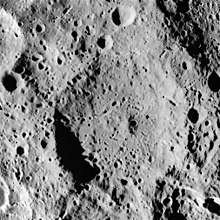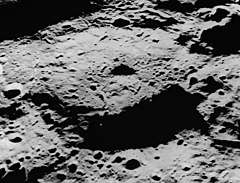Levi-Civita (crater)
Levi-Civita is a lunar impact crater formation that lies on the far side of the Moon. It was named after Italian mathematician Tullio Levi-Civita.[1] It is located just to the southwest of the large walled plain Gagarin, and nearly as close to the crater Pavlov to the south-southwest. To the northwest of Levi-Civita lies the smaller crater Pirquet.
 | |
| Coordinates | 23.7°S 143.4°E |
|---|---|
| Diameter | 102 km |
| Colongitude | 218° at sunrise |
| Eponym | Tullio Levi-Civita |

This is an eroded crater formation with smaller impacts along the rim and within the interior. The southern rim closest to Pavlov is the most eroded section, with multiple small craterlets along the edge and near the inner wall. Along the eastern rim is the satellite crater Levi-Civita F. The interior floor, although relatively level, is pitted by a number of small craterlets. There is a central ridge near the midpoint of the crater.
Satellite craters
By convention these features are identified on lunar maps by placing the letter on the side of the crater midpoint that is closest to Levi-Civita.
| Levi-Civita | Latitude | Longitude | Diameter |
|---|---|---|---|
| A | 20.5° S | 144.0° E | 17 km |
| F | 23.4° S | 145.4° E | 16 km |
| S | 24.1° S | 138.8° E | 43 km |
References
- "Levi-Civita (crater)". Gazetteer of Planetary Nomenclature. USGS Astrogeology Research Program.
- Andersson, L. E.; Whitaker, E. A. (1982). NASA Catalogue of Lunar Nomenclature. NASA RP-1097.CS1 maint: ref=harv (link)
- Bussey, B.; Spudis, P. (2004). The Clementine Atlas of the Moon. New York: Cambridge University Press. ISBN 978-0-521-81528-4.CS1 maint: ref=harv (link)
- Cocks, Elijah E.; Cocks, Josiah C. (1995). Who's Who on the Moon: A Biographical Dictionary of Lunar Nomenclature. Tudor Publishers. ISBN 978-0-936389-27-1.CS1 maint: ref=harv (link)
- McDowell, Jonathan (July 15, 2007). "Lunar Nomenclature". Jonathan's Space Report. Retrieved 2007-10-24.CS1 maint: ref=harv (link)
- Menzel, D. H.; Minnaert, M.; Levin, B.; Dollfus, A.; Bell, B. (1971). "Report on Lunar Nomenclature by the Working Group of Commission 17 of the IAU". Space Science Reviews. 12 (2): 136–186. Bibcode:1971SSRv...12..136M. doi:10.1007/BF00171763.CS1 maint: ref=harv (link)
- Moore, Patrick (2001). On the Moon. Sterling Publishing Co. ISBN 978-0-304-35469-6.CS1 maint: ref=harv (link)
- Price, Fred W. (1988). The Moon Observer's Handbook. Cambridge University Press. ISBN 978-0-521-33500-3.CS1 maint: ref=harv (link)
- Rükl, Antonín (1990). Atlas of the Moon. Kalmbach Books. ISBN 978-0-913135-17-4.CS1 maint: ref=harv (link)
- Webb, Rev. T. W. (1962). Celestial Objects for Common Telescopes (6th revised ed.). Dover. ISBN 978-0-486-20917-3.CS1 maint: ref=harv (link)
- Whitaker, Ewen A. (1999). Mapping and Naming the Moon. Cambridge University Press. ISBN 978-0-521-62248-6.CS1 maint: ref=harv (link)
- Wlasuk, Peter T. (2000). Observing the Moon. Springer. ISBN 978-1-85233-193-1.CS1 maint: ref=harv (link)
| Wikimedia Commons has media related to Levi-Civita (crater). |